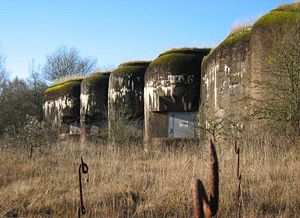Ouvrage Rochonvillers
| Ouvrage Rochonvillers | |
|---|---|
| Part of Maginot Line | |
| Northeast France | |

Block 5, Gros Ouvrage 'Rochonvillers November 2004
|
|
| Coordinates | 49°24′07″N 6°02′15″E / 49.40194°N 6.0375°E |
| Site information | |
| Controlled by | France |
| Open to the public |
No |
| Site history | |
| Built | 1930-35 |
| Built by | CORF |
| In use | Retained by French Army |
| Materials | Concrete, steel, deep excavation |
| Battles/wars | Battle of France, Lorraine Campaign |
| Ouvrage Rochonvillers | |
|---|---|

Ouvrage Rochonvillers plan
|
|
| Type of work: | Large artillery work (Gros ouvrage) |
|
sector └─sub-sector |
Fortified Sector of Thionville └─Angevillers or Ouetrange |
| Work number: | A8 |
| Regiment: | 169th Fortress Infantry Regiment (RIF) + 151st Position Artillery Regiment (RAP) |
| Number of blocks: | 11 |
| Strength: | 756 enlisted + 26 officers |
Ouvrage Rochonvillers is one of the largest of the Maginot Line fortifications. Located above the town of Rochonvillers in the French region of Lorraine, the gros ouvrage or large work was fully equipped and occupied in 1935 as part of the Fortified Sector of Thionville in the Moselle. It is located between the petit ouvrage d'Aumetz and the gros ouvrage Molvange, facing the border between Luxembourg and France with nine combat blocks. Rochonvillers saw little action during World War II, but due to its size it was repaired and retained in service after the war. During the Cold War it found a new use as a hardened military command center, first for NATO and then for the French Army.
Rochonvillers was considered an early priority for construction, and as such went through several concepts in early design while the overall concept of the Maginot Line was being investigated. It was initially proposed in 1926 as a single massive fort shielding two artillery turrets in the rear. The next concept envisioned a closely grouped arrangement of works, four peripheral units around a turreted artillery block., located somewhat to the south of the present installation. A third iteration was termed the "village", a very large and expensive concept that was opposed by the residents of Rochonvillers. The fourth version was described as a fort palmé (or palmate), based on the ideas of Colonel Tricaud, first published in the Revue du Génie in 1917. The fort palmé proposed a dispersed set of fortifications fanning out from a central subterranean trunk which would contain barracks, utilities and ammunition magazines. This concept was adopted for the entire Line, with the strong support of Marshal Philippe Pétain, in late 1927.
The Rochonvillers site was surveyed by CORF (Commission d'Organisation des Régions Fortifiées), the Maginot Line's design and construction agency, in 1929. Work by the contractor, Campernon-Bernard, began the next year, and the position became operational in 1935, at a cost of 123 million francs, the third most expensive ouvrage in the Northeast.
...
Wikipedia

